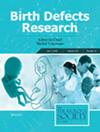To describe the methods of a congenital anomalies case–control study conducted in New Zealand, discuss the encountered methodological difficulties, and evaluate the potential for nonresponse bias.
The potential cases (n = 2710) were New Zealand live births in 2007–2009 randomly selected from the New Zealand Congenital Anomalies Registry. The potential controls (n = 2989) included live births identified from the Maternity and Newborn Information System, frequency matched to cases by the child's year of birth and sex. Mothers were invited to complete an interview covering demographic, lifestyle, and environmental factors. Response probabilities for case and control mothers were evaluated in relation to maternal age, deprivation, occupation, and ethnicity, available from the Electoral Roll, and inverse probability weights (IPWs) for participation were calculated. Odds ratios (ORs) for key demographic and selected risk factors were estimated through unconditional logistic regression, with and without IPW.
A total of 652 (24%) of case mothers and 505 (17%) of control mothers completed the interview. Younger and more deprived mothers were underrepresented among the participants, particularly for controls, resulting in inflated ORs of associations with congenital anomalies for younger age, Māori ethnicity, deprivation, and risk factors under study, such as blue-collar occupations and smoking, indicative of nonresponse bias. Nonresponse bias was minimized through IPW, resulting in ORs and exposure prevalence estimates similar to those based on the prerecruitment sample.
Attaining high participation rates was difficult in this study that was conducted in new mothers, particularly for the controls. The resulting nonresponse bias was minimized through IPW.



